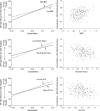For Whom the Mind Wanders, and When, Varies Across Laboratory and Daily-Life Settings
- PMID: 28719760
- PMCID: PMC5591044
- DOI: 10.1177/0956797617706086
For Whom the Mind Wanders, and When, Varies Across Laboratory and Daily-Life Settings
Abstract
Undergraduates ( N = 274) participated in a weeklong daily-life experience-sampling study of mind wandering after being assessed in the lab for executive-control abilities (working memory capacity; attention-restraint ability; attention-constraint ability; and propensity for task-unrelated thoughts, or TUTs) and personality traits. Eight times a day, electronic devices prompted subjects to report on their current thoughts and context. Working memory capacity and attention abilities predicted subjects' TUT rates in the lab, but predicted the frequency of daily-life mind wandering only as a function of subjects' momentary attempts to concentrate. This pattern replicates prior daily-life findings but conflicts with laboratory findings. Results for personality factors also revealed different associations in the lab and daily life: Only neuroticism predicted TUT rate in the lab, but only openness predicted mind-wandering rate in daily life (both predicted the content of daily-life mind wandering). Cognitive and personality factors also predicted dimensions of everyday thought other than mind wandering, such as subjective judgments of controllability of thought. Mind wandering in people's daily environments and TUTs during controlled and artificial laboratory tasks have different correlates (and perhaps causes). Thus, mind-wandering theories based solely on lab phenomena may be incomplete.
Keywords: executive control; experience sampling; mind wandering; open data; personality.
Conflict of interest statement
Figures

References
-
- Barrett L. F., Barrett D. J. (n.d.). ESP: The Experience Sampling Program [Computer software]. Retrieved from http://www.experience-sampling.org/
-
- Eckes T. (2011). Introduction to many-facet Rasch measurement: Analyzing and evaluating rater-mediated assessments. Frankfurt am Main, Germany: Peter Lang.
-
- Franklin M. S., Mrazek M. D., Anderson C. L., Smallwood J., Kingstone A., Schooler J. W. (2013). The silver lining of a mind in the clouds: Interesting musings are associated with positive mood while mind-wandering. Frontiers in Psychology, 4, Article 583. doi: 10.3389/fpsyg.2013.00583 - DOI - PMC - PubMed
MeSH terms
Grants and funding
LinkOut - more resources
Full Text Sources
Other Literature Sources
Miscellaneous

